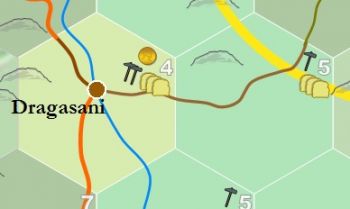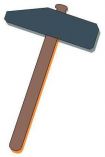Difference between revisions of "Hammer (symbol)"
Tao alexis (talk | contribs) |
Tao alexis (talk | contribs) |
||
| Line 3: | Line 3: | ||
<li style="display: inline-block; float: right; margin-left: 15px; "> [[File:Hammer (symbol).jpg||thumb|none|105px|1 Hammer]]</li> | <li style="display: inline-block; float: right; margin-left: 15px; "> [[File:Hammer (symbol).jpg||thumb|none|105px|1 Hammer]]</li> | ||
</ul></div> | </ul></div> | ||
| − | '''Hammers''' are symbols used on game maps to represent the number of accumulated facilities that a given civilised hex has constructed and presently maintains. The number of hammers possessed by a hex is determined by the [[Hex Type|hex type]], which in turn is a product of [[Infrastructure|infrastructure]]. Hex types range from 1 to 8, with a "1" indicating a highly civilised hex and an "8" indicating uncivilised wilderness. Thus, type-1 and type-2 hexes possess many hammers, while type-7 and type-8 hexes may have none at all. | + | '''Hammers''' are symbols used on game maps to represent the number of accumulated [[Facilities|facilities]] that a given civilised hex has constructed and presently maintains. The number of hammers possessed by a hex is determined by the [[Hex Type|hex type]], which in turn is a product of [[Infrastructure|infrastructure]]. Hex types range from 1 to 8, with a "1" indicating a highly civilised hex and an "8" indicating uncivilised wilderness. Thus, type-1 and type-2 hexes possess many hammers, while type-7 and type-8 hexes may have none at all. |
__TOC__ | __TOC__ | ||
== Number of Hammers == | == Number of Hammers == | ||
| Line 29: | Line 29: | ||
Maps in which hammers appear have hexes that possess two '''designations''': arable and non-arable. Arable hexes are primarily farm and pasture land. Non-arable hexes are those exploited for the sake of mining or quarrying. Type-1 to type-4 hexes are always designated as arable; type-5 to type-7 hexes may be arable or non-arable; and type-8 hexes are always treated as non-arable, though some may have the potential to be made arable. Since type-8 hexes don't gain hammers under any circumstances, they are not included on the table shown. | Maps in which hammers appear have hexes that possess two '''designations''': arable and non-arable. Arable hexes are primarily farm and pasture land. Non-arable hexes are those exploited for the sake of mining or quarrying. Type-1 to type-4 hexes are always designated as arable; type-5 to type-7 hexes may be arable or non-arable; and type-8 hexes are always treated as non-arable, though some may have the potential to be made arable. Since type-8 hexes don't gain hammers under any circumstances, they are not included on the table shown. | ||
| − | In addition to the hammers added by type, an additional +1 hammer is awarded if the hex includes a sufficiently sized [[Rivers|river]]. A +1 hammer is also given for each [[Settlements|settlement]] a hex includes. This means a type-7 hex might have one hammer, gained from a river, apparently making it equal to a type-6 hex. However, the number of hammers alone | + | In addition to the hammers added by type, an additional +1 hammer is awarded if the hex includes a sufficiently sized [[Rivers|river]]. A +1 hammer is also given for each [[Settlements|settlement]] a hex includes. This means a type-7 hex might have one hammer, gained from a river, apparently making it equal to a type-6 hex. However, the number of hammers alone does not alone measure what facilities a hex possesses. This is also partly determined by the hex type itself. |
| + | |||
| + | == Facilities == | ||
Revision as of 00:54, 24 March 2022
-
 6-mile map of the village Dragasani and surrounding area, showing two hammers in a type-4 hex and one hammer in a type-5.
6-mile map of the village Dragasani and surrounding area, showing two hammers in a type-4 hex and one hammer in a type-5.
Hammers are symbols used on game maps to represent the number of accumulated facilities that a given civilised hex has constructed and presently maintains. The number of hammers possessed by a hex is determined by the hex type, which in turn is a product of infrastructure. Hex types range from 1 to 8, with a "1" indicating a highly civilised hex and an "8" indicating uncivilised wilderness. Thus, type-1 and type-2 hexes possess many hammers, while type-7 and type-8 hexes may have none at all.
Contents
Number of Hammers
| Hex Type % |
Hammers Gained | |
|---|---|---|
| Arable | Non-Arable | |
| 7 | 0 | 2 |
| 6 | 1 | 2 |
| 5 | 1 | 3 |
| 4 | 2 | - |
| 3 | 3 | - |
| 2 | 4 | - |
| 1 | 4 | - |
Maps in which hammers appear have hexes that possess two designations: arable and non-arable. Arable hexes are primarily farm and pasture land. Non-arable hexes are those exploited for the sake of mining or quarrying. Type-1 to type-4 hexes are always designated as arable; type-5 to type-7 hexes may be arable or non-arable; and type-8 hexes are always treated as non-arable, though some may have the potential to be made arable. Since type-8 hexes don't gain hammers under any circumstances, they are not included on the table shown.
In addition to the hammers added by type, an additional +1 hammer is awarded if the hex includes a sufficiently sized river. A +1 hammer is also given for each settlement a hex includes. This means a type-7 hex might have one hammer, gained from a river, apparently making it equal to a type-6 hex. However, the number of hammers alone does not alone measure what facilities a hex possesses. This is also partly determined by the hex type itself.
